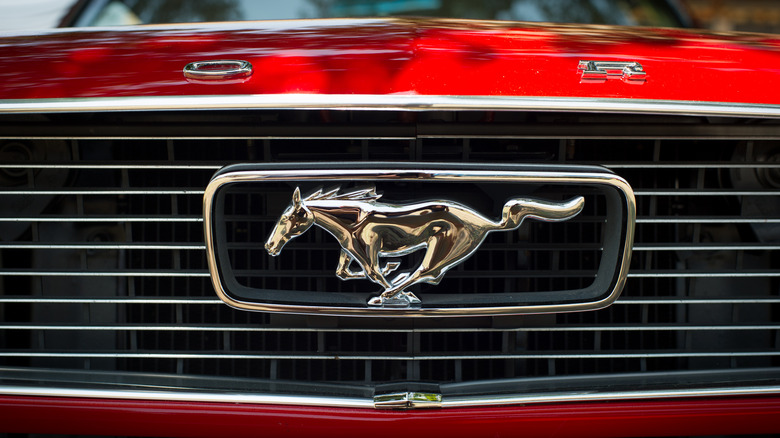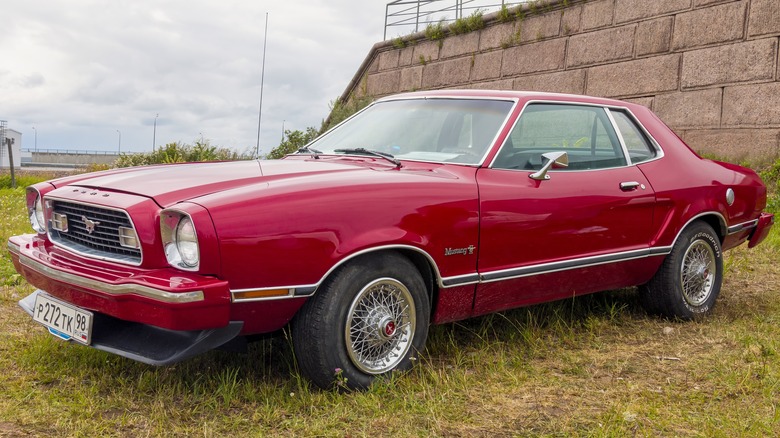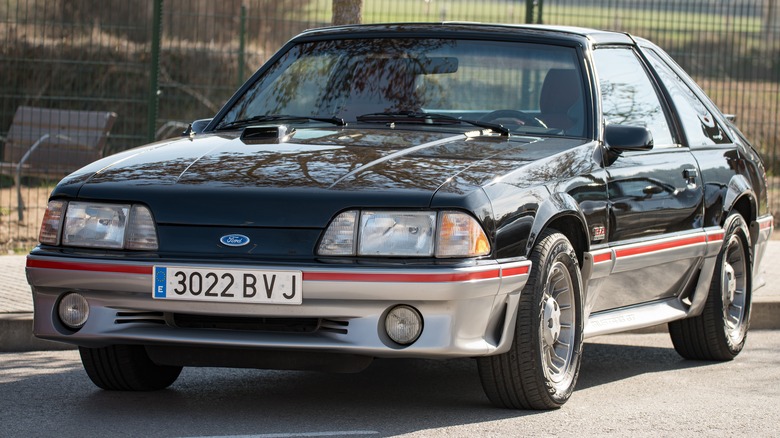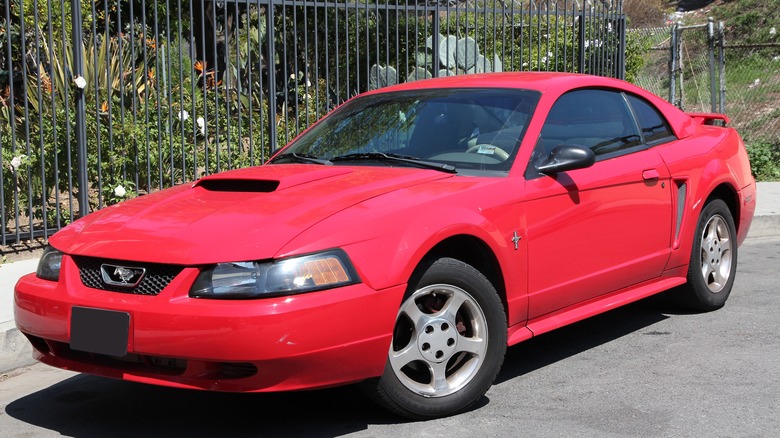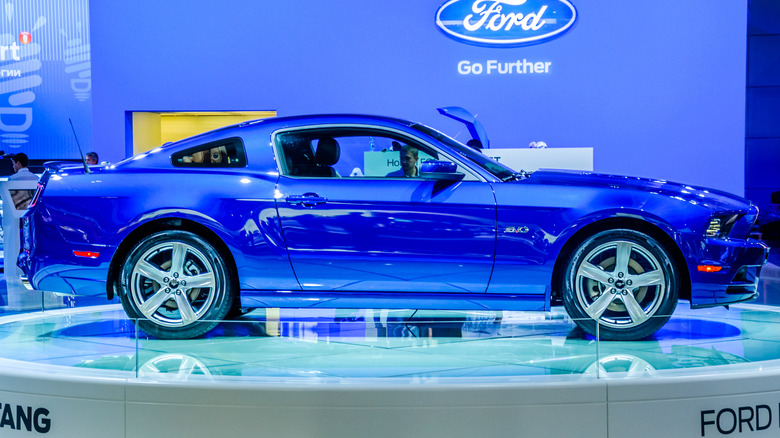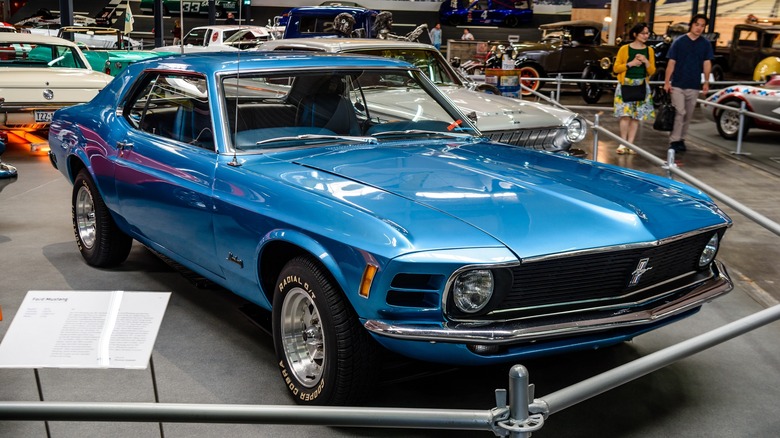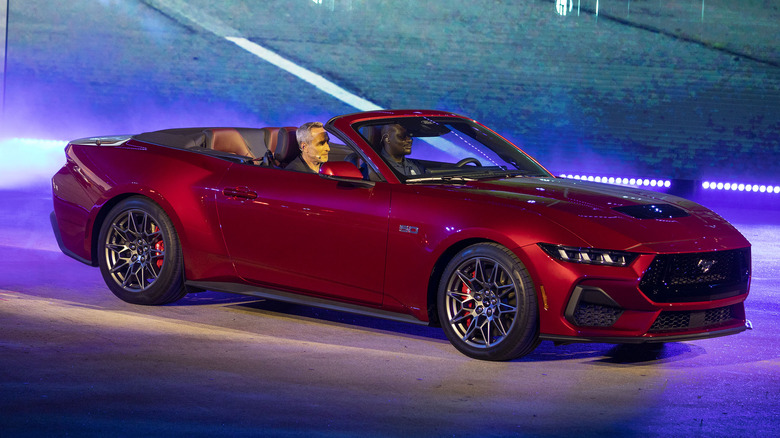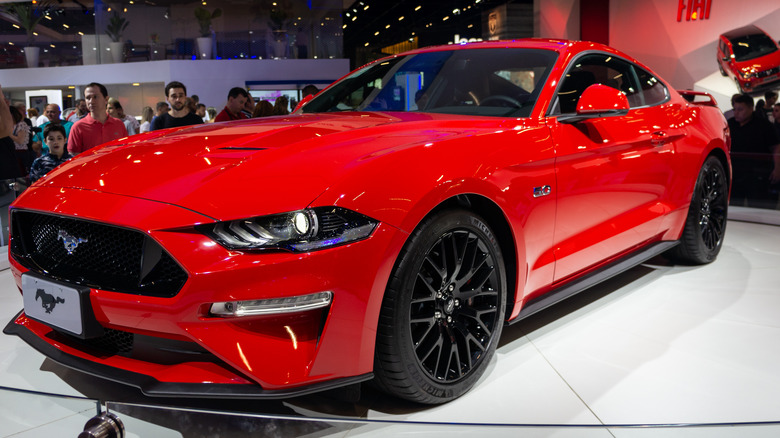Every Ford Mustang Generation Ranked Worst To Best
Often touted as the earliest muscle cars, the Pontiac GTO and Ford Mustang dropped for the 1964 model year. While the GTO earned its place in the muscle car hall of fame, the Mustang captured the hearts and minds of millions. Based on the compact Ford Falcon, with a 289 cubic inch V8 under the hood, the Mustang was such an immediate icon it coined the term for a new genre entirely: the pony car. Unlike heavier muscle cars with big-block engines, the pony car was lightweight, compact, powerful, and destined for the automotive hall of fame. The 1949 Oldsmobile Rocket 88 may have lit a long-burning fuse, but it was the Mustang that really kicked off the golden age of muscle.
Six decades after its first release, the Ford Mustang stands as the sole nameplate of the muscle era to undergo uninterrupted production. As it forges into the future with its seventh generation, let's look at how every Ford Mustang generation ranks from worst to best, based on performance, accessibility, design, and evolutionary impact.
7. Second generation (1975-1978)
After a genre-defining start, the Mustang suffered from major missteps in its second generation. The redesign rolled off the factory floor at the height of governmental crackdowns on emissions and an OPEC oil crisis that drove gas prices through the roof. But that was no excuse for how aesthetically displeasing the infamous Mustang II was.
Based on a Pinto chassis with design cues seemingly taken from the AMC Gremlin, the Mustang II hoped to compete with compact imports like Datsun's 240Z. Ford shortened the wheelbase, revamped the lines, with the only recognizable features being the pony badge and the trademark rear quarter panel indents, and gutted the power. Under the hood, consumers had the option of a 2.3-liter inline four, 2.8-liter V6, or 4.9-liter V8 — and the V8 was not even an option in 1974; prospective buyers had to wait another year for the extra pair of cylinders. And when it arrived, the V8 produced a disheartening 139 horsepower and 250 lb-feet of torque.
Though almost universally disliked amongst Mustang fans today, the second generation sold reasonably well. Every company was taking a hit on power as the concern over gas prices hit the wallet hard. The Mustang II outsold the Camaro two to one and actually won Motor Trend's Car of the Year award. Still, it was the shortest production run of any generation of Mustang, with Ford giving it the ax after a lackluster four years.
6. Third generation (1979-1993)
The 1980s were tough for American muscle. What started with the Oil Crisis of the 1970s only got worse through the 1980s. Emissions and mileage concerns trumped nearly everything else, and companies that made their reputations cramming the biggest motor into the engine bay were at a loss with how to cope.
Needing to get back to basics after the Mustang II, Ford engineers also had to deal with a second gas crisis that would hit in 1979. The result was the third-generation Mustang, known popularly as the Fox body. The Mercury Capri, Lincoln Mark VII, and the Ford Thunderbird shared the rear-wheel-drive unibody platform, which is actually the second-longest running platform in Ford's history.
Engine options included inline fours and V6s. Those who paid could get the coveted 5.0 badge, meaning a small-block Ford 302 V8 lurked under the hood. At its height, the third-generation Mustang remained a creature of 1980's car culture. The 1993 high-performance SVT Cobra put out a disappointing 235 horsepower. The Fox-body Mustang underwent a facelift between 1986 and 1987. The front end ditched the quad-headlight look in favor of the "Aero" nose with a single solid headlight.
The Mustang saw near cancellation in 1986 when it was to be replaced by the cheaper-to-produce front wheel drive Probe. An enraged fandom flooded Ford with protests, and the Mustang avoided the chopping block. The 15-year production run of the third generation might not stack up against classic pedigree or modern performance, but it enjoys an enduring fanbase of wrench-turning hobbyists.
5. Fourth generation (1994-2004)
In the waning years of the Fox-body Mustang, Ford nearly did the unthinkable by sinking it. Front-wheel-drive cars were more fuel-efficient and cheaper to build. Ford went so far as to build a prototype FWD Mustang in 1987. The Ford Probe was poised to slot into the market space occupied by the Mustang. Fans got wind of the move and flooded Ford with letters to save the Mustang. Management reversed course, and the result was the SN95 Mustang.
The consummate 90s cruiser, the fourth-generation Mustang conjures up images of Jnco jeans and frosted tips. The chassis received the Ship of Theseus treatment, replacing 80% of the major components of the third generation. At the outset, not much had changed under the hood. The premium GT iteration produced around 215 horsepower in 1994, upped to 260 in its final year of production in 2004.
Approaching its 31st year, the fourth-generation SN95 currently enjoys a decent reputation. It is mired in that awkward spot between just being an old car and becoming a classic. The 90s-era powertrain disappoints compared to the insane horsepower numbers we see today, but remain fun, sporty, and reasonably powerful. A Saleen model or souped-up Roush Mustang will fetch over six figures, but these cars remain accessible with an average cost of $22,000 on the used market.
4. Fifth generation (2005-2014)
Engine and emission technology advanced greatly since the gas crises. Ford decided to hearken back to the glory days with an all-new Mustang based on the original fastback body design. Engineers and designers looked into Mustang's history to discover what worked and what didn't. What they realized was that the first generation reigned supreme in styling.
This time, the old platform was out. After two decades, the Mustang would receive a complete reimagining. Understeer, a common complaint of SN95 owners, would be addressed with better weight management aided by a 5-inch wheelbase extension. The fifth generation, which was rear-wheel-drive-only, debuted in 2005 with a 300 horsepower 4.6-liter V8 and the original's muscular haunches and sloped rear end. To say it turned heads would be an understatement. By the end of its nine year run, the fifth-gen Mustang had sold over a million units.
The GT was up to 420 horsepower, and the United States was in the throes of a new golden age of pony power. The retro design kicked off a muscle car renaissance, with the ensuing years seeing the rebirth of the Challenger, Charger, Camaro, and even a GTO from Pontiac before their demise.
The fifth-gen remains accessible, plentiful, and relatively affordable, with an average used price hovering around $32,000 for a verifiable beast with a legitimate pedigree and plenty of power.
3. First generation (1964-1973)
Some Mustang purists will cry foul seeing the OG 'Stang at this spot on the list. There is something timeless about the first generation's flowing curves and gentle angles, a certain je ne sais quoi that sets the auto enthusiast's heart a pitter-patter. However, it's hard to argue with performance. Advancements in technology mean new cars come out of the factory more powerful and less expensive to operate and maintain than ever. Today, the classic muscle car is a comparatively mixed bag.
The original pony car began production halfway through the 1964 model year, and it did not disappoint. Initially powered by a 289 cubic inch V8 with 210 horsepower installed in a compact chassis, the Mustang detonated a muscle car craze that continues to reverberate today. By the beginning of the 1970s, the 289 had graduated into a 351 rated at 330 horsepower. Sadly, emissions regulation and oil crises cut the heart out of muscle cars, as we saw with the Mustang II.
While most couldn't keep up on the track with a modern mid-level Camry, first-generation Mustangs are among the most desired automobiles on the planet. They are works of art, pieces of automotive history, and museum classics. Unfortunately for the gearhead, prices are at an absolute premium and not likely to come down soon. The average on the used market is around $56,000, tops in the million-dollar range.
2. Seventh generation (2024)
We don't have a vast spectrum of seventh-generation Mustangs to choose from, but all signs point to it being the most advanced and performance-oriented Mustang yet.
The S650, as the seventh generation is known, debuted in 2024 amid polarizing rumors the entire line would go electric. For now, Ford has stuck with good ol' fashioned internal combustion. The lowest echelon has an EcoBoost four-cylinder with 315 horsepower, while the GT has a 480 horsepower 5.0-liter V8. Big spenders can upgrade to the Dark Horse trim for an extra boost to 500 horsepower.
As one would expect from a recently released vehicle, the used market isn't exactly flooded with junkers to tow home and rebuild. Heading to the dealer might be the most straightforward way to get your hands on Mustang's latest and greatest. Brand new buyers are looking at a price range between $33,000 and $62,000, depending on their options.
For that reason, plus the uncertainty of the future, the seventh generation is parked in second place on our list, though its potential is nearly limitless. Ford has made all the right moves with the Mustang in recent years, and there's no reason to expect that trend won't continue.
1. Sixth generation (2015-2023)
The new wave of American muscle hit its pinnacle with the sixth-generation Mustang. Powerful and sophisticated, it tilts the Mustang away from the pony car label and closer to a pure sports car (if you ignore the 2+2 configuration). Bolstered by the unfettered success of its retro fifth generation, Ford dove into what made it work in this reboot of an instant classic.
With an all-new rear independent suspension and a lineup of engines that include the most powerful 825 horsepower Super Snake, the sixth generation did not come to play. Consider that the 315-horsepower turbo-charged EcoBoost four-cylinder made a hundred more horsepower than the original 289, and you've got an idea of what this generation is all about.
Keeping the main design themes of the fifth generation, Ford subtly updated the Mustang. It's still unmistakably a Mustang, but refined. Sales speak for themselves, and this Mustang topped the sports car segment for seven of its eight years of production. The design ethos, combined with commitment to performance, marks the sweet spot for the Mustang. Any Mustang fan should be thrilled to slip behind the wheel of a sixth generation.
Prices are about where you'd expect for a modern sports car. An average cost on the used market of $42,000, topping out at $175,000, makes for something desirable but not completely inaccessible.
Methodology
Judging one automotive generation better or worse than the last is an exercise in subjectivity. One man's trash is another's treasure, after all. At SlashGear, we love all kinds of cars for all kinds of reasons, and while there are certain truisms about the Mustang (c'mon, the Mustang II is the worst, right?), not everyone will agree.
We took a holistic approach to judge the Mustang, basing our list on performance, aesthetics, design, and accessibility. After all, what is the best car in the world if you can't get near enough to appreciate its lines, hear the rumble, and maybe even touch it? Whatever your personal rankings, we hope you enjoyed our list of every Ford Mustang generation ranked worst to best.
